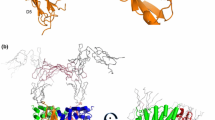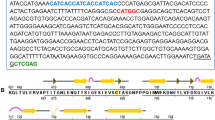Abstract
VEGF-A/VEGFR2 complex is the major signaling pathway involved in angiogenesis and the inhibition of this axis retards tumor growth and inflammatory disorders progression, reducing vessel sprouting. Signaling by VEGFR2 requires receptor dimerization and a well-defined orientation of monomers in the active dimer. The extracellular portion of receptor is composed of seven Ig-like domains, of which D2–3 are the ligand binding domains, while D4 and D7, establishing homotypic contacts, allosterically regulate receptor activity. The allosteric targeting of VEGFR2 represents a promising alternative to study neovascular disorders overcoming drawbacks related to competition with VEGF. In this work, we expressed in bacterial host domain 4 of VEGFR2 (VEGFR2D4). After protein refolding, we characterized the purified domain and administered it in mice for monoclonal antibodies production. One of them, mAbD4, was tested in ELISA assays, showing a nanomolar affinity for VEGFR2D4. Finally, the methodology here described could contribute to the development of antibodies which can allosterically bind VEGFR2 and therefore to be used for imaging purposes or to modulate receptor signaling.





Similar content being viewed by others
Abbreviations
- TEMED:
-
Tetramethylethylenediamine
- APS:
-
Ammonium persulfate
- dNTPs:
-
Deoxynucleotide triphosphates
- IPTG:
-
Isopropyl β-D-1-thiogalactopyranoside
- O.D.600 :
-
Optical density at 600 nm
- Ni–NTA resin:
-
Nickel charged-nitrilotriacetic resin
- TEV protease:
-
Tobacco etch virus protease
- EDTA:
-
Ethylenediaminetetraacetic acid
- DTT:
-
Dithiothreitol
- RP-HPLC:
-
Reversed-phase high-performance liquid chromatography
- ESI-Tof:
-
Electrospray ionization time-of-flight
- TFA:
-
Trifluoroacetic acid
- Balb c mouse:
-
Albino laboratory-bred strain
- ELISA:
-
Enzyme-linked immunosorbent assay
- PBS:
-
Phosphate-buffered saline buffer
- BSA:
-
Bovine serum albumin
- HRP:
-
Horseradish peroxidase
- OPD:
-
o-Phenylenediamine dihydrochloride
- VEGFR:
-
Vascular endothelial growth factor receptor
References
Karkkainen, M. J., & Petrova, T. V. (2000). Vascular endothelial growth factor receptors in the regulation of angiogenesis and lymphangiogenesis. Oncogene, 19, 5598–5605.
Patel-Hett, S., & D’Amore, P. A. (2011). Signal transduction in vasculogenesis and developmental angiogenesis. International Journal of Developmental Biology, 55, 353–363.
Moens, S., Goveia, J., Stapor, P. C., Cantelmo, A. R., & Carmeliet, P. (2014). The multifaceted activity of VEGF in angiogenesis: Implications for therapy responses. Cytokine and Growth Factor Reviews, 25, 473–482.
Shibuya, M. (2014). VEGF-VEGFR signals in health and disease. Biomolecules and Therapeutics, 22, 1–9.
Fong, G. H., Rossant, J., Gertsenstein, M., & Breitman, M. L. (1995). Role of the Flt-1 receptor tyrosine kinase in regulating the assembly of vascular endothelium. Nature, 376, 66–70.
Shalaby, F., Rossant, J., Yamaguchi, T. P., Gertsenstein, M., Wu, X. F., Breitman, M. L., et al. (1995). Failure of blood-island formation and vasculogenesis in Flk-1-deficient mice. Nature, 376, 62–66.
Veikkola, T., Jussila, L., Makinen, T., Karpanen, T., Jeltsch, M., Petrova, T. V., et al. (2001). Signalling via vascular endothelial growth factor receptor-3 is sufficient for lymphangiogenesis in transgenic mice. The EMBO J., 20, 1223–1231.
Lemmon, M. A., & Schlessinger, J. (2010). Cell signaling by receptor tyrosine kinases. Cell, 141, 1117–1134.
Shibuya, M. (2013). Vascular endothelial growth factor and its receptor system: Physiological functions in angiogenesis and pathological roles in various diseases. Journal of Biochemistry, 153, 13–19.
Abhinand, C. S., Raju, R., Soumya, S. J., Arya, P. S., & Sudhakaran, P. R. (2016). VEGF-A/VEGFR2 signaling network in endothelial cells relevant to angiogenesis. Journal of Cell Communication and Signaling, 10, 347–354.
Lania, G., Ferrentino, R., & Baldini, A. (2015). TBX1 represses Vegfr2 gene expression and enhances the cardiac fate of VEGFR2+ cells. PLoS ONE, 10, e0138525.
Dosch, D. D., & Ballmer-Hofer, K. (2010). Transmembrane domain-mediated orientation of receptor monomers in active VEGFR-2 dimers. FASEB Journal, 24, 32–38.
Leppanen, V. M., Prota, A. E., Jeltsch, M., Anisimov, A., Kalkkinen, N., Strandin, T., et al. (2010). Structural determinants of growth factor binding and specificity by VEGF receptor 2. Proceedings of the National Academy of Sciences of the United States of America, 107, 2425–2430.
Brozzo, M. S., Bjelic, S., Kisko, K., Schleier, T., Leppanen, V. M., Alitalo, K., et al. (2012). Thermodynamic and structural description of allosterically regulated VEGFR-2 dimerization. Blood, 119, 1781–1788.
Barleon, B., Totzke, F., Herzog, C., Blanke, S., Kremmer, E., Siemeister, G., et al. (1997). Mapping of the sites for ligand binding and receptor dimerization at the extracellular domain of the vascular endothelial growth factor receptor FLT-1. Journal of Biological Chemistry, 272, 10382–10388.
Shinkai, A., Ito, M., Anazawa, H., Yamaguchi, S., Shitara, K., & Shibuya, M. (1998). Mapping of the sites involved in ligand association and dissociation at the extracellular domain of the kinase insert domain-containing receptor for vascular endothelial growth factor. Journal of Biological Chemistry, 273, 31283–31288.
Ruch, C., Skiniotis, G., Steinmetz, M. O., Walz, T., & Ballmer-Hofer, K. (2007). Structure of a VEGF-VEGF receptor complex determined by electron microscopy. Nature Structural and Molecular Biology, 14, 249–250.
Kisko, K., Brozzo, M. S., Missimer, J., Schleier, T., Menzel, A., Leppanen, V. M., et al. (2011). Structural analysis of vascular endothelial growth factor receptor-2/ligand complexes by small-angle X-ray solution scattering. FASEB Journal, 25, 2980–2986.
Hyde, C. A., Giese, A., Stuttfeld, E., Abram, Saliba J., Villemagne, D., Schleier, T., et al. (2012). Targeting extracellular domains D4 and D7 of vascular endothelial growth factor receptor 2 reveals allosteric receptor regulatory sites. Molecular and Cellular Biology, 32, 3802–3813.
Thieltges, K. M., Avramovic, D., Piscitelli, C. L., Markovic-Mueller, S., Binz, H. K., & Ballmer-Hofer, K. (2018). Characterization of a drug-targetable allosteric site regulating vascular endothelial growth factor signaling. Angiogenesis, 21, 533–543.
Mendel, D. B., Laird, A. D., Xin, X., Louie, S. G., Christensen, J. G., Li, G., et al. (2003). In vivo antitumor activity of SU11248, a novel tyrosine kinase inhibitor targeting vascular endothelial growth factor and platelet-derived growth factor receptors: determination of a pharmacokinetic/pharmacodynamic relationship. Clinical Cancer Research, 9, 327–337.
Ferrara, N., Hillan, K. J., Gerber, H. P., & Novotny, W. (2004). Discovery and development of bevacizumab, an anti-VEGF antibody for treating cancer. Nature Reviews Drug Discovery, 3, 391–400.
Ellis, L. M. (2005). Bevacizumab. Nature Reviews Drug Discovery, 4, S8–S9.
Krupitskaya, Y., & Wakelee, H. A. (2009). Ramucirumab, a fully human mAb to the transmembrane signaling tyrosine kinase VEGFR-2 for the potential treatment of cancer. Current Opinion in Investigational Drugs, 10, 597–605.
Kendrew, J., Eberlein, C., Hedberg, B., McDaid, K., Smith, N. R., Weir, H. M., et al. (2011). An antibody targeted to VEGFR-2 Ig domains 4-7 inhibits VEGFR-2 activation and VEGFR-2-dependent angiogenesis without affecting ligand binding. Molecular Cancer Therapeutics, 10, 770–783.
Zhang, S., Gao, X., Fu, W., Li, S., & Yue, L. (2017). Immunoglobulin-like domain 4-mediated ligand-independent dimerization triggers VEGFR-2 activation in HUVECs and VEGFR2-positive breast cancer cells. Breast Cancer Research and Treatment, 163, 423–434.
Wang, W., Yin, X., Li, Y., Tian, R., Yan, J., Gao, J., et al. (2013). Prokaryotic expression, purification and antigenicity identification of mouse VEGFR2 extracellular 1-4 IgG-like domains. Journal of Southern Medical University, 33, 13–17.
Acknowledgements
We would like to thank Leopoldo Zona and Maurizio Amendola for technical assistance.
Author information
Authors and Affiliations
Corresponding author
Additional information
Publisher's Note
Springer Nature remains neutral with regard to jurisdictional claims in published maps and institutional affiliations.
Rights and permissions
About this article
Cite this article
Di Stasi, R., De Rosa, L., Diana, D. et al. Human Recombinant VEGFR2D4 Biochemical Characterization to Investigate Novel Anti-VEGFR2D4 Antibodies for Allosteric Targeting of VEGFR2. Mol Biotechnol 61, 513–520 (2019). https://doi.org/10.1007/s12033-019-00181-7
Published:
Issue Date:
DOI: https://doi.org/10.1007/s12033-019-00181-7




